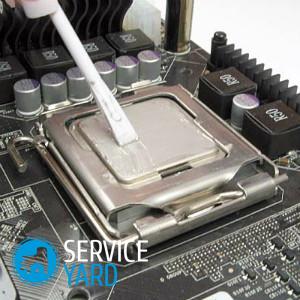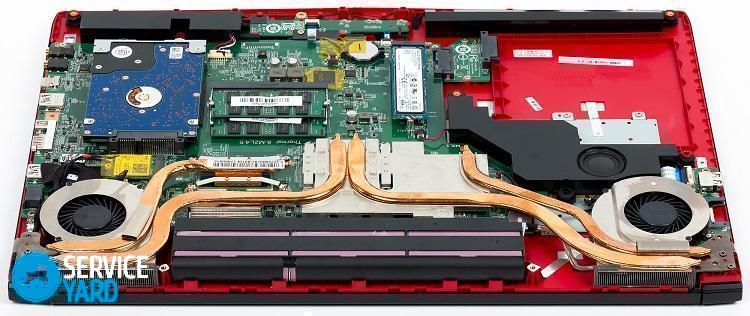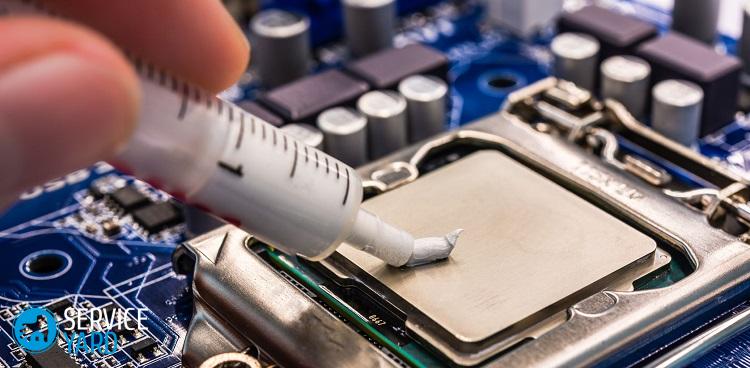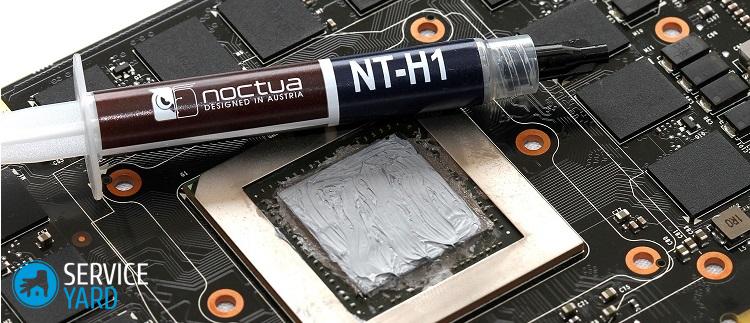Thermal grease for a laptop - which is better?

As a rule, the laptop cooling system operates in extreme modes. Therefore, the right choice of the most high-quality and effective thermal paste, which even in such harsh conditions makes it possible to ensure normal heat transfer between the radiator and the processor surface, is extremely important. In this article we will tell you what to look for when buying a thermal interface, and also answer the question: thermal grease for a laptop - which is better?
to contents ↑What should I look for when buying thermal paste?
If you buy products of a manufacturer unknown to you, then first of all pay attention to the information that is indicated on the package. As a rule, the following parameters are indicated:
- Thermal conductivity, W / (m · K) is a very important parameter of any thermal interface. Try to buy pasta for the laptop with the highest value.
- Thermal resistance is also sometimes on the packaging. This is a value that is inverse to thermal conductivity, respectively - the lower it is, the better.
- Plasticity - this property is important, first of all, in terms of the convenience of applying thermal paste to the surface of the processor.
Important! For users who have not had to use it before, it is better to purchase more plastic material, since it is more easily distributed on the surface of the processor and subsequently the tool is easier to remove.
- Resistance to temperature extremes. With constant temperature jumps, which is inevitable in the process of using a laptop, the thermal interface simply dries up.
Important! A good indicator of wear resistance for thermal paste is one year, after which it must be replaced during periodic cleaning of the laptop from dust.
- The cost of the material depends on its weight in the package and composition. As a rule, one syringe contains 4 g of paste, but in some cases it can be only 2.5 g, or even less. Moreover, often the tubes are wrapped with an opaque film, which is why it is extremely difficult to evaluate the amount of thermal paste in it visually.
to contents ↑Important! It is worth noting that even the highest characteristics of heat-conducting pastes indicated on the package do not guarantee their absolutely positive performance. Sometimes manufacturers deliberately overestimate, for example, the thermal conductivity indicated in the specification, which is why cheaper thermal interfaces can perform better in practice than their more expensive counterparts.
A few words about hotmelt
A significant difference between thermoplastic adhesive and thermal paste is that under the influence of elevated temperature it changes its state of aggregation, passing from solid to liquid.
Occasionally, this material is used in laptops, since liquid it provides a sufficiently high thermal conductivity, displacing air and the smallest irregularities on the surface of the radiator and processor.
But in the liquid state, hot melt adhesives usually pass at 100 degrees, which is already a lot for the crystal. With workers about 70-80 degrees, this material is not able to provide the quality of heat transfer that can be achieved using heat-conducting pastes. And it will be much more difficult to eliminate the old dried glue in the process of cleaning the cooling system.

Compare thermal paste
It is worth noting that not all pastas can be found on the market.In some cases, they can only be obtained by purchasing a cooler of a certain brand.
At the same time, today are widely available:
- domestic brands - AlSil-3, KPT-8;
- foreign - Arctic Silver Matrix, ARCTIC MX-2 and 3, Deep Cool Z9, Coolage CA-CT3.
Let's look at some of them to understand which thermal grease to choose for a laptop.
ARCTIC MX-2, MX-3, and MX-4
These thermal paste produces Swiss company Arctic. MX-2 can be purchased in packs of 4, 8 and 30 g, but MX-3 is sold only in syringes of 4 g.
Features:
- The material is distinguished by an advanced formula and is more suitable for overclockers, although this is not relevant for laptops.
- The stated temperature difference of these two samples is only 2.5 degrees.
- They do not conduct electricity, which is why they are safer for the components of the board and processor in case of accidental contact.
- The materials are identical in color, but have a different consistency. MX-2 is more ductile and viscous, which makes it more convenient to apply. MX-3 is quite difficult to apply with an even thin layer on the surface, as a result of which, in fact, it has already been discontinued, although the remnants can still be bought today. MX-4 - on the contrary, does not have a similar drawback, while it has a higher thermal conductivity than MX-2.
Important! All these materials have a good rating among experts due to their durability as well as high thermal conductivity. And this is very good just for the laptop in general and its cooling system in particular.

Arctic Silver 5
It is no longer a new thermal grease, but today it is the choice of many, as it is time-tested and is still considered the quality standard:
- On sale there are packings of 12 and 3.5 g.
- Among most other thermal interfaces, its thermal conductivity is the highest - 8.7 W / (m · K).
- Silicone is used as a binder here, and the proprietary composition is made of synthetic oils, because of which it strongly adheres to any elements. But even despite this, it is quite easy to apply to the surface of the processor even to an inexperienced user.
Important! This material also does not conduct electric current. In addition, over time, it does not dry out and does not flow.
Arctic Silver Matrix
This is a more budget version of the thermal paste considered above:
- It is sold in a syringe without packaging of 2.5 g.
- This material has a fairly thick and viscous consistency, but it is quite easily applied to the processor.
Coolage CA-CT3 Nano
This thermal interface is a product of the notorious Skolkovo:
- The consistency of the paste is quite thick, but at the same time very plastic and sticky.
- Probably, as the name of the product implies, due to the presence of nanoparticles, this material is smeared with an even and thin layer, while the thermal conductivity is declared quite good - more than 4 (m · K).
- The paste also has dielectric properties, does not dry out for a long time, so it will also behave well on any laptop model.

Which thermal grease is better for an inexpensive laptop?
The thermal interfaces we examined earlier, with very few exceptions, are quite expensive, have excellent thermal conductivity and high wear resistance. They are best used for gaming devices where the cooling system requires more performance.
If you are going to clean an ordinary office laptop, which is used mainly for working with documents and on the Internet with the replacement of thermal paste, then it is quite possible to do with the domestic, cheaper AlSil-3.
to contents ↑Important! Undesirable for mobile computers - this is an outdated heat-conducting paste KPT-8, although it is still in demand today. Its rating is low, as it dries quickly on the heat exchange surface, which quickly loses its performance characteristics. In addition, it has a thermal conductivity of only 0.8 W / (m · K), which for a laptop will be clearly low.
Stock footage
Now you know the answer to the question which thermal grease to choose for a laptop. Given our tips and tricks, you can choose really high-quality material for your laptop that will greatly facilitate and accelerate its work.
- How to choose a vacuum cleaner taking into account the characteristics of the house and coatings?
- What to look for when choosing a water delivery
- How to quickly create comfort at home - tips for housewives
- How to choose the perfect TV - useful tips
- What to look for when choosing blinds
- What should be running shoes?
- What useful things can you buy in a hardware store
- Iphone 11 pro max review
- Than iPhone is better than Android smartphones



